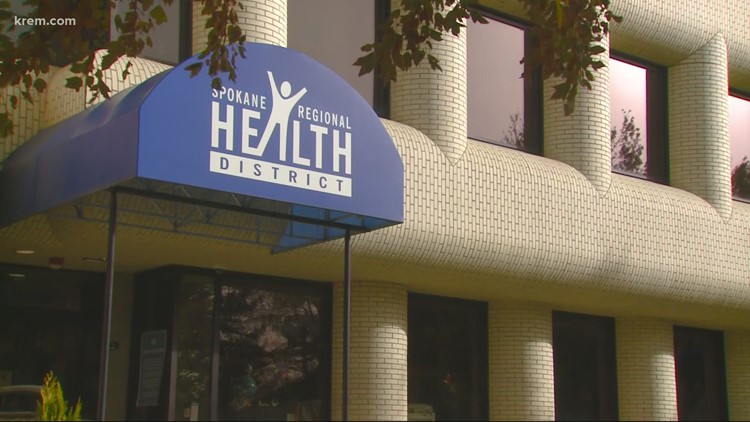SPOKANE, Wash. — The Spokane Regional Health District recently hired a company to conduct a survey on the agency’s response to the COVID-19 pandemic from January 2020 to July 2020.
The district hired Constant Associates, which is based in California, to conduct what they call an After-Action Report. The report is meant to examine lessons learned, best practices and ways to improve when it comes to responding to COVID-19. The company compiled information from SRHD documents, an online survey with stakeholders and interviews with SRHD staff and partner organization staff. The health district spent $32,305 on the report and CARES Act funding covered the cost.
The health district said the review was done as part of a requirement for federal grant money. The report evaluated SRHD in five categories: internal and external communications, agency continuity, responder safety and health, interagency coordination and whole community partnerships. The report lists both strengths and areas of improvement in each category.
Administrative Officer Amelia Clarke said the health district will utilize the after-action report to improve our internal operations and planning efforts for future responses.
SRHD fired Dr. Bob Lutz from his position as Health Officer in late October 2020. The internal issues around the firing are not discussed in this report.
Communication with staff and the public
According to the report, in the area of internal and external communications SRHD’s strength was using social media and streaming platforms to push information and interact with the public.
“There was a perception that SRHD provided relevant, credible, and timely information and guidance to the public with most of the respondents agreeing (35%) or strongly agreeing (55%),” the report says.
The report said an area of improvement was enhancing internal communications among all of SRHD’s staff.
“Cross-departmental and interagency cooperation could be improved through better communication (e.g. establishing common terminology, improving responsiveness within the chain of command, ensuring relevancy of information),” the report reads. “This presents an opportunity for SRHD to expand their internal communications strategy. Employees desire regular, tailored, personalized messaging from within the organization which can add to the positive health of business operations.”
To improve, the report says SRHD plans to assign a deputy public information officer and an internal communications position to ensure consistent communication flows to all staff and the public in a timely manner. They also plan to make an internal communications strategy to address the various levels of staff involvement.
Timecard confusion and staff reassignments
In the area of agency continuity, the report says SRHD contacted people from municipalities, the county and regional incident management teams early in the COVID-19 response to provide surge staffing in order to maintain the delivery of essential public health services.
“Approximately 130 of SRHD’s 258 staff have been assigned to the COVID-19 response since it began, to help augment staffing levels for the public health response,” the report says. “This has allowed SRHD to activate continuity plans and procedures to remain operational even during multiple surges throughout the pandemic. It also allowed for staff to remain employed versus having to lay off staff when their grant programs were not being administered due to the restrictions, like staying home, due to the pandemic.”
The report says SRHD should continue to have discussions about continuity planning to support the ongoing needs of the COVID-19 response. During interviews, the report says staff had concerns about their timecards.
“Timekeeping became an issue as individuals were reassigned to the response,” the report reads. “Electronic timecards were a challenge to access remotely and required to be validated by program managers – not by those managing staff in the ICS (Incident Command System) response. With long-term reassignments to response, upholding proper timekeeping was an administrative priority.”
Staff reassignments were also met with mixed reviews, according to the report.
“At first, many staff were reassigned based on the allowance of their funding streams for their day-to-day position, as well as general availability,” the report says. “While this worked in the short-term, it did result in several staff being assigned to roles that they did not have adequate skillsets and training to perform.”
The report says before COVID-19, SRHD had not implemented a broad staff reassignment for an emergency.
Psychological, emotional support offered but staff felt overworked
The next area where SRHD was evaluated was with responder safety and health. According to the report, staff members who were surveyed were asked if the training they received before COVID-19 prepared them for the response role they were assigned. The report says 40 percent either agreed or strongly agreed, 31 percent disagreed or strongly disagreed and 24 percent were neutral.
The report says SRHD’s strengths in this area were implementing health and safety procedures as well as providing emotional and psychological support services to staff.
“Staff have appreciated resources for individual counseling offered by SRHD and information to support selfcare, mental health, stress management, and 24/7 emergency resources during the ongoing response,” the report reads. “In the set of survey questions for SRHD staff, the second-best ratings were respondents agreeing that psychological and emotional support were readily available.”
However, the report found that staff moral needed to be built up by offering additional training.
“Almost one-third of survey respondents indicated the training they received did not adequately prepare them and a quarter indicated they were neutral,” the report says. “This presents an opportunity for SRHD to not only prepare staff to respond successfully in their role, but simultaneously decrease staff stress through training improvements.”
The report also found that SRHD needs to explore options for surge capacity to sustain the long-term response and reduce fatigue among staff.
“Overwhelmingly, SRHD staff reported working beyond an average 40- hours per week, with some putting in 70-80 hours,” the report says. “Some staff remained on call, working nights, and/or responding over the weekend. Response duties frequently take time away from day-to-day responsibilities, and often there are not enough people available to provide adequate position depth. This contributes to staff feeling burned out and exhausted, but unable to fit in time off or take care of themselves. With no end in sight for the pandemic, the ability to sustain the needed response, without further impacting regular SRHD programs, was a concern for employee respondents.”
To improve in these areas, SRHD plans to revise its response plans and provide additional training to staff to make sure they understand response procedures. They will also “continue to search for efficiencies and solutions to address the overload and fatigue of staff. Capitalizing on existing partnerships and identification of new collaborative efforts will continue to be a priority to reduce staff burnout,” the report says.
Interagency coordination
The report found SRHD’s response to COVID-19 strengthened relationships with response partners.
“Over 50% of 100 survey respondents agreed they had established relationships and opportunities to plan, train and exercise with SRHD,” the report says.
The report found that SRHD’s command and control during ‘Unified Command’ was not well defined or understood.
“Prior to COVID-19, SRHD had only been involved in a few coordinated community wide responses such as 2009 H1N1, 2015 Windstorm, 2016 Norovirus outbreak at House of Charity, and hazardous air quality incidents from wildland fires,” the report says. “The COVID-19 response was the only time SRHD has been involved in a true Unified Command structure with the county and municipalities. This resulted in some great collaborative efforts as well as some unique challenges with command and control.”
SRHD plans to give additional training on things like Unified Command, Unity of Command, Delegation of Authority, Decision Making Authority and other ICS concepts, the report says.
Social justice and equity of COVID-19 response
When it came to community partnerships, the report found 64% of individuals spoke to social justice and equity issues impacting the COVID-19 response.
The health district was able to leverage partnerships to strengthen community engagement and delivery of public health services, especially when it came to helping people experiencing homelessness.
“By partnering with shelters, SRHD was able to comprehend specific challenges the community was experiencing,” the report reads. “Ultimately, this helped inform the shelters response and the services they were able to provide. Stakeholders shared that food security for vulnerable populations became a key area of concern. The response saw the creation of a large and extensive network; including shelters, food banks, and local businesses.”
The report recommended SRHD expand public and private partnerships to increase the impact of public health response and address social equity issues.
“In interviews, stakeholders acknowledged that they were able to set up and engage with public and private partners across the region to address community needs,” the report says. “However, many expressed that these partnerships and engagements should have occurred prior or even earlier in the response.”
In the report, SRHD said it will continue to find ways to “engage with marginalized and disproportionately impacted populations throughout the rest of this response.”
It is unclear when or if SRHD will conduct an evaluation for the rest of its response to the pandemic.
“We would not have had the capacity to complete an evaluation in-house while still in the midst of response efforts,” SRHD Spokesperson Kelli Hawkins said. “However, its results provided great value by identifying many mid-course corrections that we were able to implement quickly to improve efficiencies and outcomes. We likely won’t be contracting for another report as we don’t have the funds at this time, but we will conduct one in-house in the future.”
Administrative Officer Amelia Clarke also sent KREM a statement regarding the report:
“Two of the areas that the after-action report identified were internal communications and whole community partnerships," Clarke said. "We’ve already taken steps to improve internal communications with an intranet site that has information for staff on COVID-19 and our response efforts. This is especially useful for those who are not directly involved in COVID-19 response. Also, one of our great accomplishments related to whole community partnerships has been the establishment of an equity branch. SRHD is a leader in the state of Washington and nationally by having a formal equity branch in our COVID-19 response – this is a best practice that we will prioritize in all of our future responses.”



